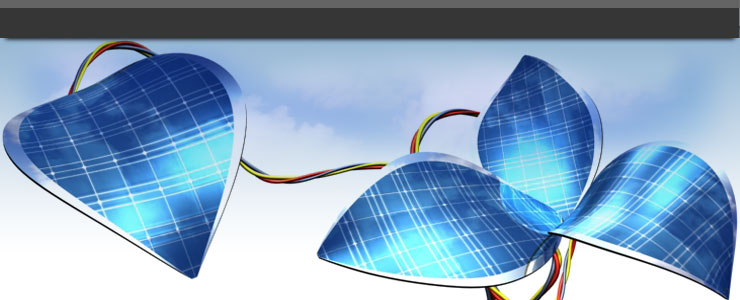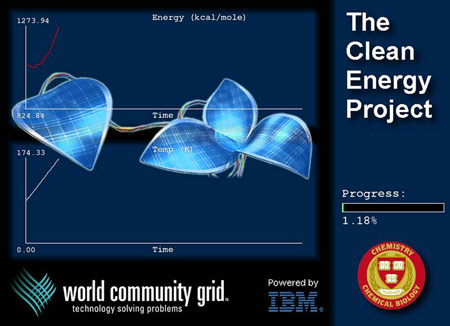
Проект "The Clean Energy project - phase 1"
----------------------------------------------------------------------------------------------------------
- Официальный сайт
- Официальная статистика по команде "Ukraine"
- официальный форум
- Статья о проекте на нашем сайте
Как присоединиться читайте в главном топике World Community Grid

----------------------------------------------------------------------------------------------------------
Дата основания команды - 28.02.2005 Капитан - rilian
----------------------------------------------------------------------------------------------------------
О проекте:
Dear World Community Grid users: We want to thank you all for contributing your computer's idle power to the Clean Energy Project! Our team here in the Department of Chemistry and Chemical Biology at Harvard University is very excited about having the opportunity to closely work with you in finding new materials for alternative energy applications. We are jointly searching thousands of possible compounds as candidates for producing solar cells made of organic materials.
Most of the solar cells are made of highly structured semiconductor substrates. In contrast, our approach seeks to understand how photosynthetic organisms such as plants harvest sunlight using not-so-structured organic molecules. We plan to use the natural design principles of these organisms to create solar cells that behave similarly. Early stages of the project will help us understand many fundamental aspects of how to improve the performance of these organic-based materials. With your help, we will study how organic molecules stack to form thin films that can be used to develop flexible, lightweight solar cells, and possibly solar paint! Isn't that amazing? In later stages, we will study the electronic properties of these molecular compounds to better understand how the energy flows in these materials. One of our goals is to collaborate with experimental research groups that will synthesize the most promising chemical compounds; compounds that would be identified by using your donated computer time.
In this respect, your contribution is very important because you are helping us to dramatically accelerate the process of understanding the fundamental science behind these novel solar cells made of organic materials. Remember: the deployment of this technology has the potential to systematically lead the development of the next generation of solar cells. We will keep you posted as the project advances on our findings in this forum. You can also visit our website for more information: http://cleanenergy.harvard.edu.
Thank you again for donating your computer time for this project.
The Clean Energy Project team.
Project Status and Findings:
Information on the Clean Energy Project can be found on these pages and on the Clean Energy @ Harvard website. The latest status updates can also be found at this site. To discuss or ask questions about this project, please visit The Clean Energy Project Forum.
Mission
The mission of the Clean Energy Project is to find new materials for the next generation of solar cells and later, energy storage devices. By harnessing the immense power of World Community Grid, researchers can calculate the electronic properties of tens of thousands of organic materials – many more than could ever be tested in a lab – and determine which candidates are most promising for developing affordable solar energy technology.
Significance
We are living in the Age of Energy. The fossil fuel based economy of the present must give way to the renewable energy based economy of the future, but getting there is the greatest challenge humanity faces. Chemistry can help meet this challenge by discovering new materials that efficiently harvest solar radiation, store energy for later use, and reconvert the stored energy when needed.
The Clean Energy project uses computational chemistry and the willingness of people to help look for the best molecules possible for: organic photovoltaics to provide inexpensive solar cells, polymers for the membranes used in fuel cells for electricity generation, and how best to assemble the molecules to make those devices. By helping us search combinatorially among thousands of potential systems, World Community Grid volunteers are contributing to this effort.
Approach
Researchers are employing molecular mechanics and electronic structure calculations to predict the optical and transport properties of molecules that could become the next generation of solar cell materials.
a) Molecular mechanics calculations: Some of the computers contributing to the Clean Energy Project are carrying out molecular mechanics calculations of molecular crystals, thin films and molecular and polymer blends to study the packing arrangements and for predicting charge and excitation energy transport properties of the candidate materials. These calculations will be carried out using the CHARMM molecular mechanics package developed by the Karplus group at Harvard University.
B) Electronic structure calculations: To obtain the relevant optical and electronic transport properties, some of the computers connected to the Clean Energy Project will be computing calculations using wave function methods (such as Hartree-Fock or second-order perturbation theory) and density functional theory. These calculations will help researchers build a database of molecular properties that together with the results of the molecular mechanics calculations will help us identify potential candidate materials. The electronic structure calculations will be performed with the Q-Chem quantum chemistry code, developed by Q-Chem, Inc.
Ссылки по теме:Как происходят рассчеты: программа подбирает структуру поглощающей поверхности и подвергает ее воздействию освещения. Поверхность выделяет электроэнергию и нагревается. Программа измеряет эти параметры со временем
Как выглядит графический клиент:





